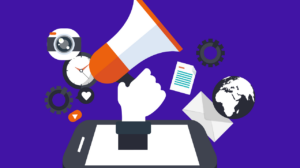Whether it is about designs, businesses, or processes, the concept of design thinking is all about creative problem-solving. This concept focuses on addressing the needs of people, as well as improving bottom-line results and customer satisfaction. It transcends beyond just design and applies to different work processes to systematically learn and apply human-centered techniques to solve problems in an innovative way.
Isn’t addressing your customer needs all about creating better products or experiences? But design thinking is not as simple as it sounds. Its implementation can be a tricky business.
Design Thinking
According to Interaction Design Foundation, “Design thinking is a non-linear, iterative process which seeks to understand users, challenge assumptions, redefine problems and create innovative solutions to prototype and test.”
Design thinking is not a recent phenomenon. It has been in existence for ages in design processes. Be it designing of monuments or automobiles, designers have intricately applied a human-centric creative process to build meaningful solutions.
Human-centric product designing is very often an afterthought in the business world, resulting in enterprises creating products which fail to meet customers’ real needs. However, human-centric design approach has proved to be a key differentiator as companies have reaped the benefits of creating products shaped by human needs. In order for this approach to be adopted across large organizations, it needed to be standardized.
How the Design Thinking Process Works
Design-thinking comes in different phases such as empathize, define, ideate, prototype, test, and implement.
Empathize: Research extensively to gain knowledge about users. It is important to know what users do, feel or think. It is all about getting into the user’s shoes. In this phase, it is about directly observing what users do, understanding their thought process, and asking ‘what encourages or discourages users?’
Define: Combine observation with research to determine your users’ problems. In identifying your users’ needs, you can showcase opportunities for innovation, establish patterns and draw parallels when it comes to users’ current experiences. In the define phase, effectively use the data gathered in the “empathize” phase to garner insights.
Ideate: Brainstorm crazy, creative ideas to address unmet user needs identified in the define phase. During this phase, bring together your team members in a collaborative spirit. Chart out different ideas and share them with one another, revamping and building on them.
Prototype: Build tangible representations for a subset of your ideas. Understand which components of your ideas work and which do not. Assess the impact vs. feasibility of your ideas through feedback. Be open to changes and iterate.
Test: Return to your users for feedback. Test your prototype in front of real customers and verify whether it achieves your goals. As you are executing your vision, continue to test along the way.
Implement: Put the vision into effect. Ensure that your solution is materialized and touches the lives of your end users. Remember, design thinking for an organization is all about transforming end user’s life.
Advantages of Design Thinking
Design and design thinking has at its heart the motivation to solve problems. It could be simplification of a complex journey users need to take. It can be about solving time problems, a new method of product development, or helping customers make choices or informed decisions. It involves:
- Designing integrated solutions where each part syncs with the system in whole and not designing silo or disjointed pieces.
- Getting closer to current and potential users.
- Building customer-centric products and solutions.
- Developing empathy with customers.
Essential Elements of Design Thinking & its Implementation
Educating users is the key to successful adoption. Define and communicate milestones, share progress reports and evangelize your successes. Each phase is meant to be iterative and not a linear process. It is common to return to the two understanding phases, empathize and define, after an initial prototype is built and tested.
One of the most challenging parts of the process is resistance to change. In most cases, it is observed that people feel anxious about change that is imposed. The processes of design thinking should be an integrated and collaborative approach, giving voice to people’s opinion across the organisation. The process should allow the team to be a part of a defining moment.
All emerging ideas will take shape and everyone should be reassured that they have been considered. While the obvious assumption is that design thinking is what happens to the product at the end, the truth is that the process is in fact about a methodology of analysis. The process is a catalyst for change and evolution.
Conclusion
Businesses are heavily investing in discovering and deploying new solutions. Design thinking brings about a new wave of change for better-designed products and services and great value to the organisation in terms of user experience, as well as driving growth and profitability.




